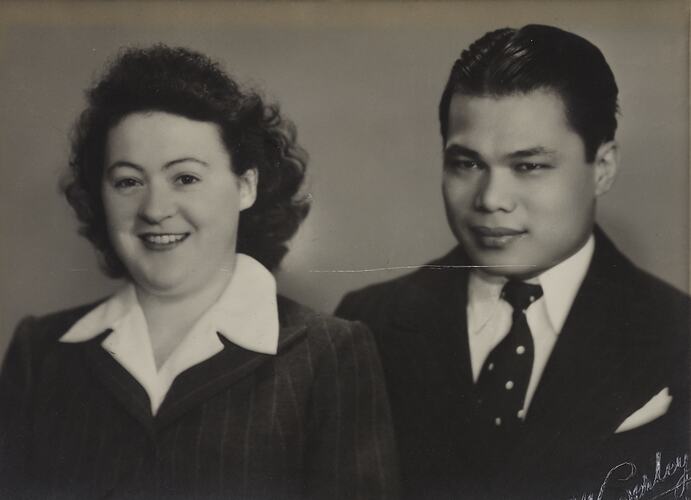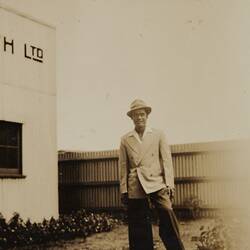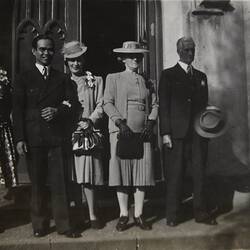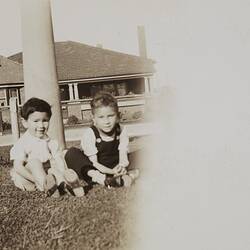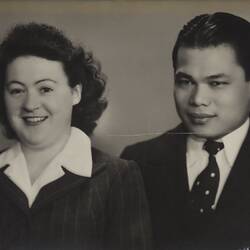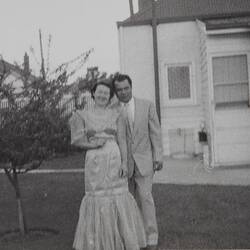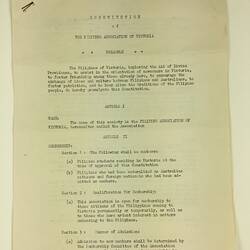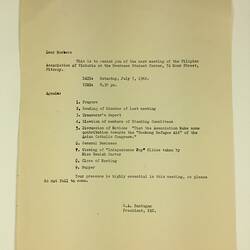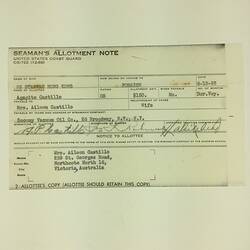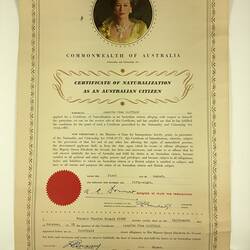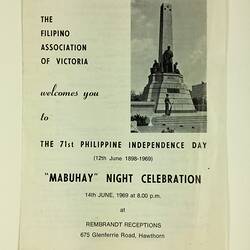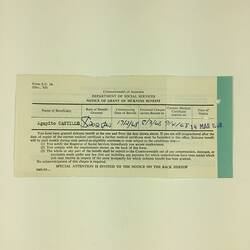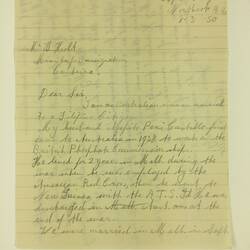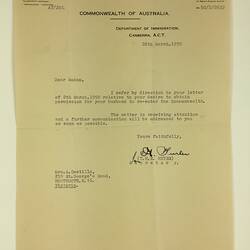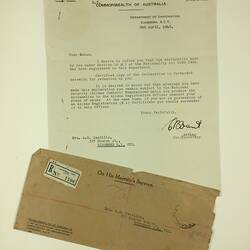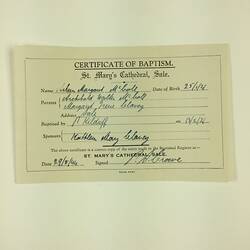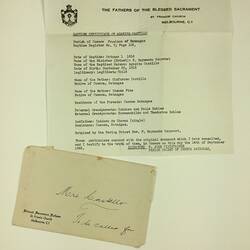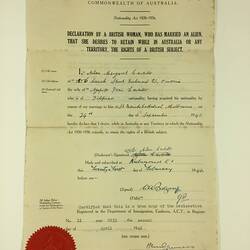Summary
A collection relating to the experiences of seamen from the Philippines during World War II portrays a time of prejudice and challenges for the men, and the local Anglo-Australian women they married.
The Collection:
The Museum holds a collection of material relating to the migration and settlement experiences of seamen from the Philippines during and after the World War II era in Australia; and the experiences of the local Anglo-Australian women they married. The central story of the collection is that of Aileen McColl and Agapito Castillo who married in Melbourne in 1945. Agapito worked for the British Phosphate Company and like other men from the Philippines was caught in Melbourne during the outbreak of World War II.
This collection represents an important narrative in Australia's migration history, regarding the challenges faced by seamen born in the Philippines caught in Melbourne during the outbreak of World War II and unable to return home, trying to settle in Melbourne and marry locally-born women of Anglo-Australian background. It also reveals the prejudice these women themselves faced.
The collection portrays a small community of these men and women and their families, connected through family relationships; it demonstrates the vagaries of bureaucracy (including the varying enforcement and exemptions applied), and reflects the continuation of the White Australia policy during this period as couples faced challenges in gaining and maintaining their citizenships, and re-entering Australia upon departure. When Australian-born women married men from countries excluded by the White Australia policy, the men were excluded from citizenship and automatic re-entry rights. Women often lost their own citizenship status and during war were subject to regulation.
The collection also includes material relating to the formation of the Filipino Association of Victoria in 1962, in which Agapito Castillo was involved.
Aileen McColl and Agapito Pine Castillo:
First Meetings:
Aileen McColl (born in Sale, Victoria in 1921) and Agapito Castillo (born in Philippines in 1916) met while Agapito was living and working in Melbourne for two years during World War II. Aileen worked at Marsh & Quirk Tailors in Little Collins Street Melbourne making men's suits. Here she met Muriel Miller whose father Albert was an SEC linesman who met many men from the Philippines working on the phosphate ships which used to tie up in Footscray and Yarraville. He brought some of the seamen to the family home in Footscray and Muriel's sister Kathleen married one of them (Muriel married an Indonesian seaman working for the Dutch KPM Company). Kathleen introduced Aileen to Agapito at a dance, possibly one organised by the Church of England Mission to Seamen in Melbourne where local women volunteered as hostesses. Agapito worked with the American Red Cross and was one of a number of seamen from the Philippines who worked on ships sailing the Pacific, including to Australia and New Zealand.
Getting Married:
Agapito travelled to Papua New Guinea as a seaman, and upon his return to Melbourne he and Aileen married at St Patrick's Cathedral, Melbourne, September, 1945. It was a time of widespread prejudice. Aileen's parents chose not to attend the wedding and Aileen chose to get married on a Monday to reduce the number on onlookers.
Forced Departure:
On 18 June 1946 the couple's first child Margaret Semeona Castillo was born and Agapito continued to work in Melbourne. When Aileen was expecting her second child Francisco (born 14 December 1947), they successfully applied for a one year visa extension for Agapito due to the impending birth. The Federal Government then advised the couple that, because of the continuing White Australia Policy restrictions, Agapito would have to leave the country. Margaret was three years old and Francis was nine months when their father left as a member of an overseas oil tanker.
Aileen becomes an avid letter writer, making requests to Government to allow her husband's return to Australia once his contracts at sea concluded. Agapito would try to transfer to ships coming to Australia but if the route changed he wouldn't make it. And if he did, the ships discharged their cargo and left leaving little time to reunite the family (his daughter Margaret remembers her father leaving gifts from the many places he docked).
Lost Citizenship:
Aileen lost her Australian citizenship after their marriage because citizens of the Philippines were classified by the Australian Government as 'aliens'. She recalls that Agapito had an 'alien's card' and they had to report to the police regularly when he was in Australia. She remembers feeling like a criminal the first time Agapito took her to the police station to report: she was thumbprinted and the policeman was embarrassed because there wasn't a clean place on the roller towel for her to dry her hands. Aileen had to supply all her personal details, a photograph and had to become accustomed to a policeman coming to the door to check on her.
Years Apart:
In 1950, further correspondence by Aileen outlines the ongoing situation of the family trying to reunite in Melbourne, as well as Aileen's loss and then re-gaining of her citizenship due to marriage. From 1951-53 documents record Agapito as employed as a seaman on board the ships SS Stan Durban and SS Stanvac Hong Kong, contracted by the Socony Vacuum Oil Company, New York, where he also lived when in dock. Since Agapito was still unable to obtain permission to catch a freighter back to Australia, his salary payments were all given to Aileen (then living in Northcote). She carefully saved them, and when Agapito finally was able to return home they used these savings to purchase their first home in Carnegie where the family still reside. In 1954, Agapito received a three month visa exemption to return to Melbourne.
Finally Reunited:
In 1958, Agapito applied for and finally received Australian citizenship and received his certificate at Caulfield Town Hall; after years of separation, Aileen and Agapito were finally reunited. They went on to have four more children and Agapito became active in the newly formed Filipino Association of Victoria during the 1960s.
Filipino Association of Victoria:
Instrumental in the formation of this association was Father Brian Chapman who was the Superior of the Colomban Fathers at Essendon. Father Chapman had been stationed in the Philippines and had a great love for the country and its people. He made contact with and helped to bring together the small community of Philippines people living in Melbourne. They organised concerts where traditional folk dances were performed and eventually decided to form an association.
According to the Castillo family, the constitution was written at the home of Agapito and Aileen Castillo in Carnegie. Mr Gonzalo Bantugan was the first president and Agapito was a member. The meetings and many of the functions and parties were held at the Overseas Student Centre at 74 Moor Street Fitzroy. The centre was funded by the Archdiocese of Melbourne and the chaplain was provide by the Colomban Fathers.
More Information
-
Keywords
-
Authors
-
Article types
